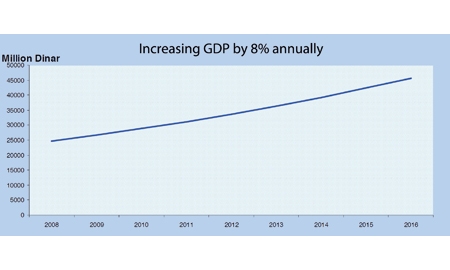Kurdistan’s impressive economic growth, estimated at 12 per cent during 2012, has been driven largely by the country’s oil industry. However, the government’s Regional Development Strategy is betting on more growth in other sectors, notably housing construction, agriculture and tourism, to maintain the pace of economic development.
The Regional Development Strategy for the Kurdistan Region 2012-2016, designed by the Ministry of Planning, sets some ambitious goals for the next four years. They include reducing the unemployment rate from 17 to 4 per cent, creating 100,000 jobs a year and achieving an average annual GDP growth rate of 8 per cent.
That growth would include an expansion of the agricultural sector by at least 15 per cent, manufacturing industries by 5 per cent and the tourism sector by 7 per cent.
Although Kurdistan’s economic future will be marked by the potential of its oil industry, the composition of its GDP already shows the rising power of other areas of the economy. Housing currently represents 20.6 per cent, while tourism contributes 19.3 per cent, trade 14.5 per cent, and agriculture 6.8 per cent, according to figures from the Kurdistan Board of Investment.
In the fast-growing housing sector, according to Bloomberg, Kurdistan will need to spend 200 billion dinars ($175 million) a year on home construction during the next decade to overcome an expected shortage. This would suppose building 5,000 housing units a year and investing 200 billion dinars annually to implement this plan.
In the tourism sector, the country is trying to take advantage of its archaeological sites – for example, the ancient area around the capital city, Erbil – which have been singled out by publications such as National Geographic magazine or the New York Times as among the most attractive in the world.
As for the agriculture sector, the Regional Development Strategy foresees a “10 per cent increase in annual use of agricultural land; providing protection for 80 per cent of cultivable land against desertification and damage during five years; and increasing the water storage capacity up to 5 per cent of available river flows during five years, through building four dams during the period (2012-2016).”
However, the basis of Kurdistan’s economic growth will continue to be oil and gas. The region holds approximately a third of Iraq’s total oil reserves, or about 45 billion barrels. The region’s current production stands at 100,000 barrels of oil per day, but plans are to raise output to 1 million barrels by 2015, with at least 10 per cent of the total devoted to exports.
Over the past year, the country has begun to export directly and to sign contracts with the foreign oil majors, Exxon Mobil Corp, Total SA, Chevron and Gazprom.
Kurdistan’s gas reserves could well become a key source of supply to Europe and Turkey, once the planned Nabucco pipeline comes online. The KRG government plans separate export pipelines direct to Turkey in next two years.
0 COMMENTS